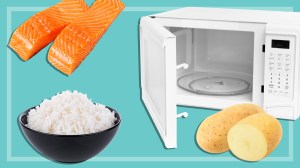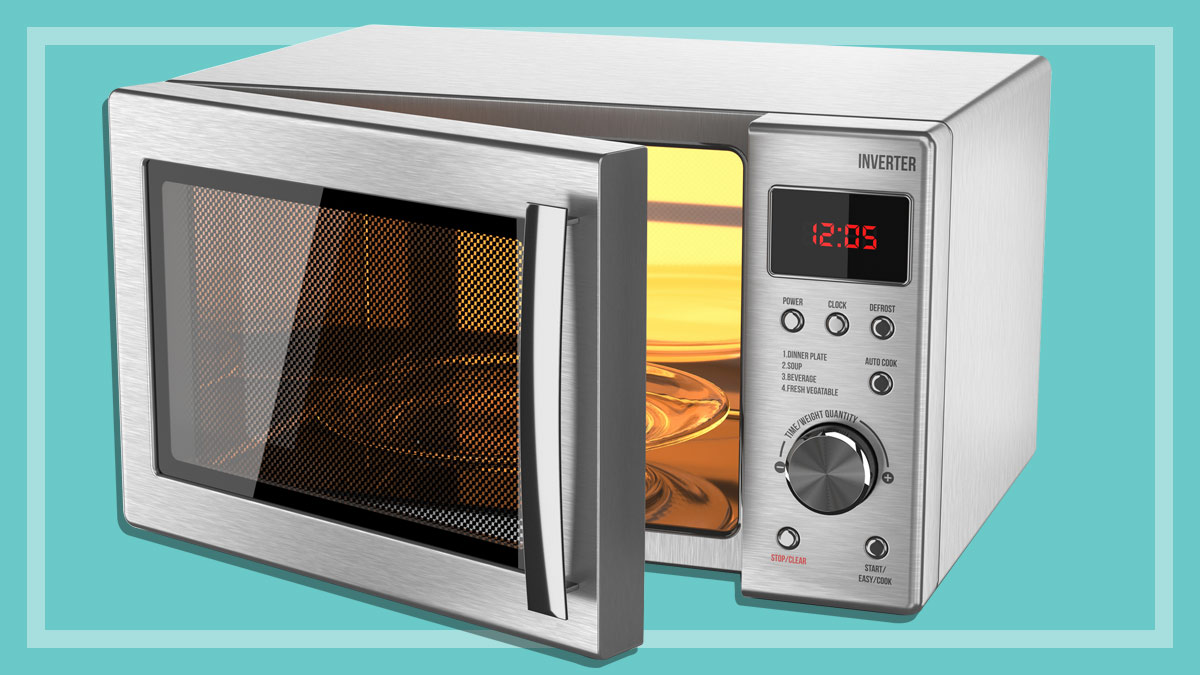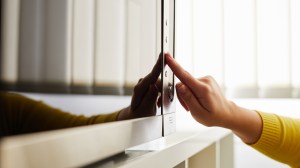
How to buy a great microwave

Microwaves are handy items to have in any kitchen, for anything from reheating leftovers to defrosting a chicken.
Whether you’re upgrading an ageing microwave or buying one for the first time, this guide will help you find a model with the features you need.
How does a microwave work?
A microwave is a handy kitchen appliance that cooks, reheats and defrosts food relatively quickly. As the name suggests, microwaves use a magnetron that produces microwaves.
The microwaves are reflected inside the metal interior of the oven, which is then absorbed by the food and causes the water and fat molecules in the food to oscillate. This process generates the heat needed to cook, reheat or defrost your food.
Will a microwave save you money?
A microwave can speed up your cooking time, but it can also help you be more sustainable and save you on your energy bill. Microwaves are more energy-efficient than stovetops and ovens in most types of cooking, and their running costs can be as low as $10 a year.
You can also save more money by switching off your microwave at the power point when you’re not using it. Yearly standby costs for microwaves aren’t high – generally only a few dollars (or less) – but it’s a simple way to reduce your household energy consumption.
And while microwaves are a great way to defrost frozen food, you can save even more energy by defrosting food in the fridge. It’ll take a bit longer and require some forward planning, but if you’re not in a rush it’s an easy change to make.
Sizing up a new microwave
Many kitchens now have a dedicated space for a microwave, so you’ll need to measure that gap and look for something that fits while still allowing space for air circulation.
If you don’t have a spot carved out, the microwave is going to take up your precious bench space, so think about how much you’re willing to sacrifice.
Most microwaves are around 50cm wide, 30cm high and 40cm deep. They’ll need about 10cm space around the sides for ventilation, and 20cm at the top where the vents are usually located.
Interior dimensions are important, too. Will your microwave-safe dishes actually fit inside? Don’t be shy about taking them into the store to check.
Built-in microwaves and trim kits
Built-in microwaves
Having all your appliances integrated on one wall seems to be a trend for complete kitchen renovations and new builds, and a built-in microwave could fit right in.
If you decide on a built-in microwave (which range in price from $500 to over $3000) it’s important to follow the cut-out dimensions recommended, as adequate ventilation is required. Some microwaves with a grill or convection function require hard-wiring by an electrician and may need to run on a 20 amp circuit.
Remember, if you ever need to replace your microwave you’ll need to consider the replacement size, as it needs to be the same dimensions with similar ventilation requirements and electrical capacity to avoid a major cabinetry replacement.
Trim kits
Microwave trim kits ($150–500) fit over the faceplate of the microwave and sit on a pedestal inside a cabinet to give you the look of a built-in. Rear ventilation is required and must reach the full height of the cabinet with no obstructions.
Trim kits are model-specific so not all microwaves can accommodate one. Standard width is around 60cm, but the height may differ to fit different size cabinets. This is to match the width of a wall oven to give a uniform look. If you need to replace your microwave, you probably won’t be able to use the same trim kit.
How do inverter microwaves work?
An inverter microwave works by heating, reheating or defrosting food at a constant power level for the duration of the cooking time. A regular microwave on medium power will heat on full power for half the time, then turn off for half the time, whereas an inverter will continually heat using 50% of its power and won’t need to turn off.
Key features to look for
Controls
Look for easy-to-use controls and good instructions on the display. The best microwaves won’t require you to refer to the instruction manual. Some have a quick-access user guide inside the door, which can help.
Visibility
A bright interior light and large transparent viewing window will let you check your food as it cooks. Many models have poor visibility through the door. Where possible, ask the store to power up the microwaves you’re considering buying to make sure the visibility is good.
Cleaning
Check there aren’t too many gaps or crevices inside or outside the microwave that could trap food and grease. Control pads are easier to clean than dials and buttons. Stainless steel may look flash but it’s harder to keep clean.
Automatic defrost
Automatic defrost prompts you to enter the weight and type of food, and the microwave then calculates the defrosting time.
Sensor cooking
Sensor programs take automatic functions one step further by measuring vapours emitted by the food to control the cooking time. No weight required.
Quick boost/start
This is a single button that delivers a 30-second or one-minute burst of 100% power, which can be increased in increments – particularly handy for reheating.
Time adjust
This lets you increase or decrease the programmed time without stopping cooking.
Multi-stage programming
This setting performs a sequence of functions, such as defrost, cook and then leave to stand.
Child safety lock
This gives you a sequence of buttons to activate and deactivate the microwave.
Kitchen timer
The digital timer can be used to time other kitchen tasks or cooking times.
Noise
Keep in mind that all microwaves beep during or at the end of operation – and most keep on beeping till you open the door to remove your food. Some also have cooling fans that can continue operating when cooking has finished. A few microwaves give you the option to adjust the noise levels – we’ve started recording this feature in our most recent tests.
How much do microwaves cost?
In our latest microwaves review, models range in price from around $48 up to $1599, and up to $3199 for a built-in model. It’s a big price range, so what are you getting for those extra dollars? Usually it’s a brand name, a larger cooking capacity, and design elements.
If those are important to you, prepare to front up the extra cash. Of course, you don’t want it to fail in its first five years, so reliability is also important.

Australia’s best microwave brands
We identify the best microwave brands based on our test results for more than 90 microwaves over the past seven years and feedback from our members on satisfaction and reliability.
Our experts have tested microwaves and convection microwaves from the major brands, including Breville, LG, Panasonic, Samsung, Sharp, Westinghouse and more.
Best microwave brand for 2024: Panasonic
Panasonic takes out the microwave Best Brand for 2024, with strong scores in our test results in addition to being a reliable brand with highly satisfied customers. Breville comes a close second, also with strong results.
We also considered Kmart, LG, Miele, Samsung, Sharp, Smeg and Westinghouse for Best Brand, however these brands didn’t meet our strict eligibility criteria. Kmart is below average for customer satisfaction while LG and Sharp are below average for reliability. Samsung and Westinghouse have below average test scores while Miele and Smeg didn’t have enough tested models to be eligible.
It’s important to note that the performance of specific product models may vary quite significantly, so don’t assume that one brand’s products are the best across the many different features, functions and price points.
To find out which specific models we recommend based on our test results, and to make sure you buy the best, click on the ‘Recommended’ box in the filters section of our microwave reviews or convection microwave reviews.
The Best Brand recommendation for microwaves is based on our test results for microwaves over the past seven years, as well as customer satisfaction and reliability information submitted by CHOICE members on their experience with the brand.
The recommendation is given to companies with a clear lead over their competitors during the test period, and no more than two recommendations are given during each period.
Best Brand eligibility is tough – to be considered, we must have tested a minimum of five models, and a brand must have received a minimum of 50 responses to the CHOICE member survey. Additionally, brands must score a minimum of 60% and be above the average score for average test score, reliability and satisfaction for consideration.
The following criteria determines the Best Brand recommendation.
- Average test score – 40%
- Brand reliability – 30%
- Customer satisfaction – 20%
- Recommended ratio – 10%
Average test score
This measures the average score for all microwave models tested in the CHOICE labs for each brand. Our testers assess:
- microwave performance by conducting reheat, defrost and cooking tests
- a convection microwave’s extra capabilities by conducting extra cooking tests
- how easy the controls are to use and the quality of instructions
- the effectiveness of the light and viewing window
- how easy the microwave is to clean
- how noisy the beeping alerts and cooling fans are.
For more details, see how we test microwaves.
Brand reliability
Our CHOICE customer insights team surveyed over 7100 CHOICE members in 2021 about whether they’ve run into any problems with their microwave in the past 12 months.
Customer satisfaction
Our survey also asks how satisfied members are with their microwave. So even if a microwave has a fault after six months, it’s still possible for it to have a high satisfaction score – perhaps the company has customer service that goes beyond expectations, or the product is simply too good, despite some performance quirks.
Recommended ratio
This represents the percentage of microwaves that CHOICE recommends for each brand. The greater the number of models that earn a recommendation, the higher the recommended ratio score.
2023: No winner
2022: No winner
2021: No winner
2020: LG
2019: LG
Best Brand score
Panasonic: 78%
Breville: 77%
Average test score
Panasonic: 79%
Breville: 77%
LG: 87%
Miele: 82%
Kmart: 79%
Sharp: 79%
Westinghouse:76%
Samsung:72%
Smeg: 71%
Reliability score
Panasonic: 91%
Breville: 92%
LG: 89%
Miele: 96%
Kmart: 96%
Sharp: 89%
Westinghouse: 92%
Samsung: 93%
Smeg: 77%
Customer satisfaction score
Panasonic: 84%
Breville: 83%
LG: 84%
Miele: 89%
Kmart: 81%
Sharp: 83%
Westinghouse: 83%
Samsung: 84%
Smeg: 71%
Recommended ratio
Panasonic: 20%
Breville: 25%
LG: 100%
Miele: 100%
Kmart: 43%
Sharp: 38%
Westinghouse: 17%
Samsung: 0%
Smeg: 0%
Number of models tested
Panasonic: 15
Breville: 8
LG: 6
Miele: 2
Kmart: 7
Sharp: 8
Westinghouse: 6
Samsung: 5
Smeg: 1
Number of recommended models
Panasonic: 3
Breville: 2
LG: 6
Miele: 2
Kmart: 3
Sharp: 3
Westinghouse: 1
Samsung: 0
Smeg: 0
Note: Kmart, LG, Miele, Samsung, Sharp, Smeg and Westinghouse were also considered for Best Brand, however, did not meet our strict eligibility criteria. Click the arrows above to see how these brands performed in other aspects of Best Brand.
Australia’s most reliable microwave brands
Our CHOICE Product Reliability Survey asks thousands of members about the appliances they own, what they think of them, and how well they’ve held up over time.
The information they provide gives us a really good indication of how various microwave brands stack up over time – something we can’t test in our labs.
The top performers
Most reliable brands: Kmart, Miele, Samsung, Breville, Westinghouse, Panasonic, Sharp and LG.
Highest owner satisfaction: Miele, Samsung, Panasonic, LG, Breville, Westinghouse, Sharp and Kmart.
Common issues
The most commonly reported problems respondents mentioned were about:
- the microwave’s light
- temperature and/or heating
- the door, sealants, and/or hinges.
In our most recent survey, 5964 people told us about their microwave. Panasonic was the most popular brand, with 32% of our members saying they have a Panasonic microwave, followed by LG (17%) and Sharp (16%). Standard or conventional microwaves were far more common than convection or microwave ovens.
Microwave reliability and satisfaction
Reliability score
Kmart (159): 96%
Miele (73): 96%
Samsung (225): 93%
Breville (136): 92%
Westinghouse (59): 92%
Panasonic (1034): 91%
LG (579): 89%
Sharp (494): 89%
Aldi (Stirling/Lumia) (77): 77%
Smeg (67): 77%
Customer satisfaction score
Kmart (159): 81%
Miele (73): 89%
Samsung (225): 84%
Breville (136): 83%
Westinghouse (59): 83%
Panasonic (1034): 84%
LG (579): 84%
Sharp (494): 83%
Aldi (Stirling/Lumia) (77): 76%
Smeg (67): 71%
Note: Number in brackets shows the sample size. Differences of 5% or more for reliability are significantly different.
In total, 7100 CHOICE members participated in our 2021 Product Reliability Survey. Of these, 84% (5964 respondents) said they had bought a microwave brand new.
Reliability
Our reliability figures are based on owner assessment, not test data. We use the data we collect from CHOICE members to rate the most popular brands for reliability. We ask owners if their product has broken down in the past 12 months, and we take into account the age of the products so we can compare brands in a fair way.
Owner satisfaction
We ask owners to tell us what they think of the products they own, rating them from ‘Excellent’ to ‘Terrible’. We’ve used this information to give each brand an owner satisfaction rating so you can see what people who use these brands each day think of them.
Our brand reliability scores help guide you when choosing a product, letting you know that the brand is well regarded by CHOICE members for customer satisfaction and reliability.
Are microwaves dangerous?
Microwaves are a safe method of food preparation if used correctly, and the food is just as nutritious (more so in some cases) as any other cooking method. The electromagnetic waves stop as soon as you cut off the power and open the door, and they don’t remain in the food and make it radioactive.
The allowable limit for microwave leakage is 5mW/cm2 at a distance of 5cm, and the radiation leakage spot tests we’ve conducted on microwaves are well below this level.
All microwaves sold in Australia must pass specific requirements about leakage in accordance with relevant Australian standards. Leakage is possible if you have a poorly fitting or damaged door, so you should have it inspected by a qualified technician or return it to the manufacturer for repair.
If a microwave is in good working order, it should be perfectly safe, but it’s good practice to stand 30cm away from it when it’s in use.
How to clean a microwave
Microwaves can get dirtied with splatters and odours but the good news is you don’t need to spend too much time or elbow grease to get them clean. For regular cleans, you can wipe out the microwave with warm soapy water. For built-up grease, our home economist Fiona Mair says you can clean and deodorise your microwave in minutes using a lemon and the power of steam.
Place a small, microwave-safe bowl of water with a few slices of lemon into the microwave and heat on high for two minutes. Then simply wipe the walls, door and ceiling of the microwave with a dry microfibre cloth.
How to dispose of your old microwave
If your microwave no longer works, and it can’t be repaired, it’s time for an upgrade. But don’t forget you can keep it out of landfill by recycling it. Useful materials in a normal microwave include glass, galvanised steel, copper, aluminium and ferrite, as well as trace metals.
Microwaves that use inverter technology are generally lighter and use fewer materials (this is because they use an inverter circuit board instead of a conventional power transformer) but metals such as copper from these boards can also be recycled. Visit recyclingnearyou.com.au/whitegoods for locations near you.
Related




